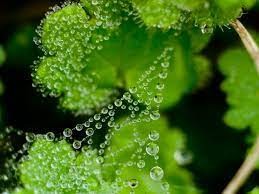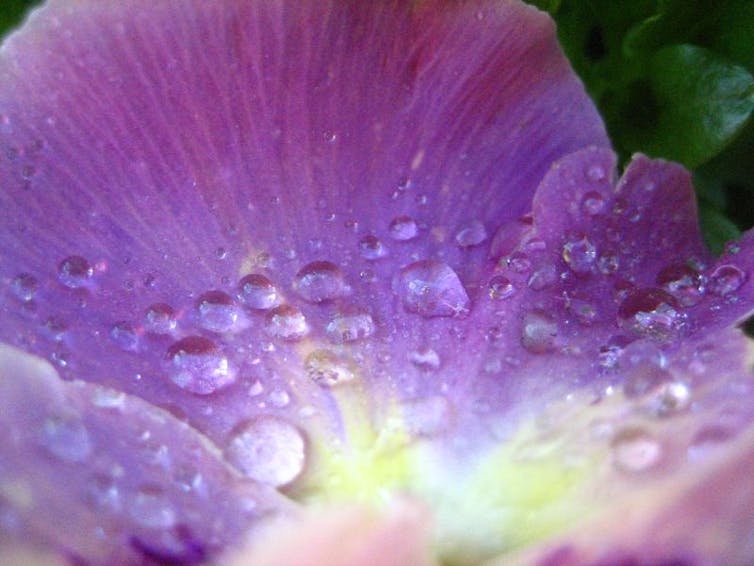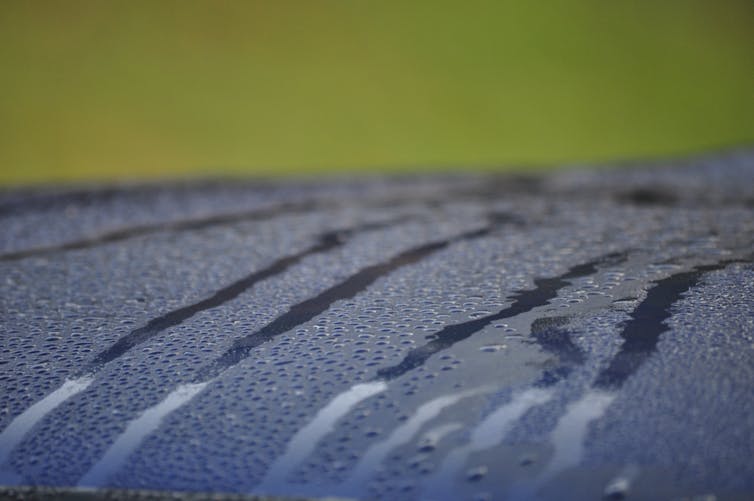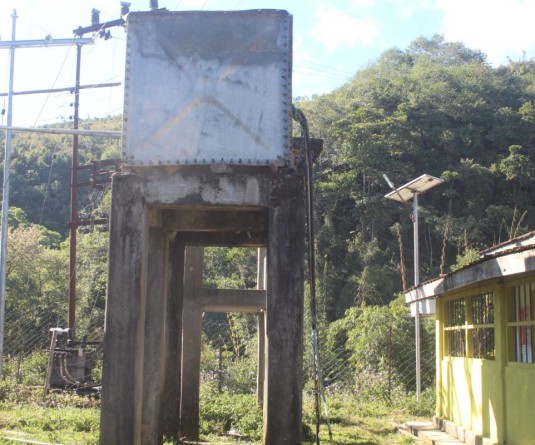As water vapour (gas) cools, it slows down. The small parts, the molecules, start to gather together, especially on cold things like a cool leaf. Flickr/Richard Nix, CC BY-SA

Dylan Korczynskyj, University of Notre Dame Australia
Curious Kids is a series for children in which we ask experts to answer questions from kids. You might also like the podcast Imagine This, a co-production between ABC KIDS listen and The Conversation, based on Curious Kids.
I am wondering: is dew the same as rain? What is dew? Thank you – Leo, age 3.
Great questions, Leo!
I am a plant ecologist, and rain and dew are things I need to understand. Plant ecology is all about learning how plants are affected by the world around them (their environment) in the same way that you are affected by your environment.
For example, if you go outside you might consider putting a hat on so you don’t get burnt by the hot sun. Or you might put a coat on so you don’t get cold or wet. Plants are greatly affected by water, whether it comes from dew or rain. So are rain and dew the same?
Read more: Curious Kids: How do you know that we aren't in virtual reality right now?

Dew is the water droplets that we find in the morning on leaves and other things outside, and usually in spring or winter when the air is cold. It is similar to rain because it forms from condensing water vapour. I hear you asking, “…but what does condensing water vapour mean?”. I will try to explain.
Water can be a liquid (we drink liquid water), it can also be a solid (think of ice cubes), and it can be a gas, which we call water vapour. When water warms up enough it breaks into small, fast-moving parts, called molecules. It changes from being a liquid to a gas – water vapour – that floats about in the air.

Think about how the steam (which is water vapour) from your hot bath floats about your bathroom.
So, now you understand what water vapour is and how it is made, think about what will happen if the fast moving water vapour cools down: this will help you understand condensation.
As the vapour cools, it slows down. The small parts, the molecules, start to gather together, especially on cold things (like a cool leaf) or in cold areas (like high in the sky). Scientists would say the water condenses.
If enough water molecules gather together (like a little water molecule “meeting”) they form a droplet of liquid water.
This same process (condensation) occurs when the steam from your hot bath condenses on the cold bathroom mirror – have you ever drawn a face on it?

Whether the droplets that form are dew or rain depends on where they formed.
Rain forms from water vapour condensing high in the sky as clouds. If enough water molecules gather together, it will get too heavy to stay in the sky and fall down on your head as rain.
Dew forms from water vapour that condenses on cold surfaces on the ground, like grass or a car on a cool morning (it usually gets a bit cooler early in the morning).

All plants need water and so do we – it is very precious to all life! Most plants get their water from the soil, but this water originally fell as rain and then soaked into the soil.
Some plants and lichen (lichen are like plants) can absorb water from dew. It’s a little bit like they are “drinking” the dew.
I hope this helps.
Read more: Curious Kids: where do clouds come from and why do they have different shapes?
Hello, curious kids! Have you got a question you’d like an expert to answer? Ask an adult to send your question to curiouskids@theconversation.edu.au

Please tell us your name, age, and which city you live in. We won’t be able to answer every question but we will do our best.
Dylan Korczynskyj, Associate Professor, University of Notre Dame Australia
This article is republished from The Conversation under a Creative Commons license. Read the original article.






